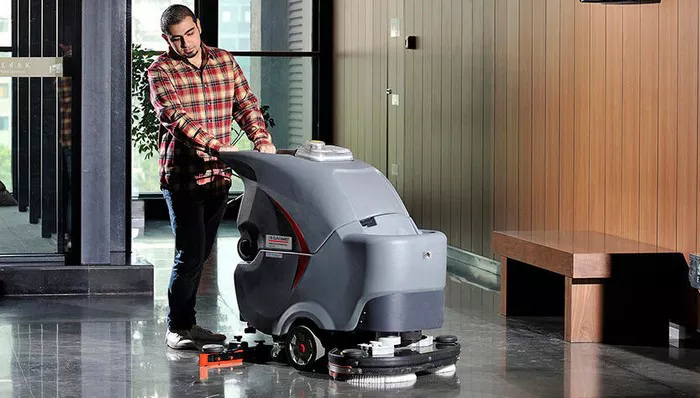Maintaining clean floors is essential for any space, whether it’s a home, office, or industrial environment. Floor scrubbing machines offer an efficient way to achieve cleanliness and hygiene without the labor-intensive effort of manual scrubbing. With various types and models available, selecting the best floor scrubbing machine can be daunting. This guide aims to simplify the decision-making process by highlighting key considerations and features to look for.
Types of Floor Scrubbing Machines
Floor scrubbing machines come in different types, each catering to specific cleaning needs and environments:
Walk-Behind Scrubbers: Ideal for medium to large areas, walk-behind scrubbers are manually operated and offer robust cleaning power. They are suitable for both smooth and uneven surfaces, providing thorough cleaning with adjustable scrubbing pressure.
Ride-On Scrubbers: Designed for large spaces such as warehouses and shopping malls, ride-on scrubbers enhance productivity by allowing the operator to cover larger areas quickly. They are battery-powered for extended runtime and typically feature ergonomic designs for operator comfort.
Compact Scrubbers: Perfect for confined spaces or areas with obstacles, compact scrubbers are smaller in size but still pack significant cleaning capabilities. They maneuver easily around furniture and tight corners while delivering effective cleaning performance.
Robotic Scrubbers: Utilizing advanced technology, robotic scrubbers automate the cleaning process, navigating autonomously through predefined routes. They are ideal for maintaining cleanliness in busy environments without requiring constant operator supervision.
Key Features to Consider
When evaluating floor scrubbing machines, several features play a crucial role in determining their effectiveness and suitability:
Cleaning Efficiency: Look for machines with adjustable brush pressure and variable cleaning modes to accommodate different floor types and levels of soiling. Higher brush speeds and effective suction capabilities contribute to better cleaning results.
Battery Life and Runtime: For battery-powered scrubbers, consider the battery type, capacity, and runtime on a single charge. Longer runtime reduces downtime for recharging and enhances productivity.
Tank Capacity and Water Usage: Machines with larger solution and recovery tanks require fewer refills and emptying cycles, making them more efficient for large-scale cleaning tasks. Efficient water usage helps in conserving resources.
Maneuverability and Size: Evaluate the machine’s maneuvering capabilities, especially in tight spaces and around obstacles. Compact designs with swivel steering enhance maneuverability and ease of operation.
Noise Levels: Especially important in noise-sensitive environments such as hospitals or offices, quieter machines minimize disruption while cleaning without compromising performance.
Durability and Maintenance Requirements: Choose machines constructed from durable materials capable of withstanding frequent use and harsh cleaning chemicals. Easy maintenance features such as tool-free brush and squeegee replacement simplify upkeep.
Factors Influencing Machine Selection
Several factors influence the selection of a floor scrubbing machine based on the specific cleaning requirements and environment:
Floor Type: Different floor surfaces (e.g., tile, concrete, vinyl) may require specialized brushes or pads for optimal cleaning results. Machines with adjustable brush pressure accommodate varying floor textures without causing damage.
Area Size: Consider the total area to be cleaned regularly to determine the appropriate machine size and capacity. Larger areas benefit from ride-on or walk-behind scrubbers with wider cleaning paths and larger tanks.
Cleaning Frequency: High-traffic areas or environments with stringent hygiene standards may require more frequent cleaning. Machines with quick-drying capabilities and efficient water extraction reduce downtime between cleaning sessions.
Budget and Cost of Ownership: Evaluate upfront costs along with long-term expenses such as maintenance, parts replacement, and operational costs (e.g., electricity, water). Opting for energy-efficient models can lead to cost savings over time.
Environmental Considerations: Choose eco-friendly machines with reduced water consumption and energy-efficient features to minimize environmental impact. Certifications such as Energy Star indicate compliance with environmental standards.
See Also: The 6 Best Tools for Cleaning Tile Floors
Benefits of Using Floor Scrubbing Machines
Investing in a quality floor scrubbing machine offers numerous benefits beyond cleanliness:
Improved Hygiene: Removes dirt, debris, and germs effectively, reducing the risk of infections and creating a healthier environment.
Enhanced Safety: Eliminates slippery surfaces by removing residues and spills promptly, reducing the likelihood of slips and falls.
Time Efficiency: Completes cleaning tasks faster than manual methods, allowing staff to focus on other essential duties.
Long-Term Cost Savings: Reduces labor costs associated with manual cleaning and extends the lifespan of floors by maintaining them in optimal condition.
Professional Appearance: Presents a clean and well-maintained appearance to visitors and customers, enhancing the overall image of the space.
Maintenance and Care Tips
Proper maintenance ensures optimal performance and extends the lifespan of floor scrubbing machines:
Daily Cleaning: Rinse and clean brushes, squeegees, and recovery tanks after each use to prevent residue buildup and maintain suction efficiency.
Scheduled Inspections: Regularly inspect machine components, including hoses, filters, and batteries, for signs of wear or damage. Replace worn-out parts promptly to prevent further damage.
Cleaning Solutions: Use manufacturer-recommended cleaning solutions to avoid damaging machine components and ensure effective cleaning results.
Storage: Store machines in a clean, dry area away from direct sunlight and extreme temperatures. Follow manufacturer guidelines for proper storage practices.
Training and Education: Provide training to operators on machine operation, safety protocols, and maintenance procedures to maximize efficiency and prevent accidents.
Conclusion
Choosing the best floor scrubbing machine involves assessing cleaning requirements, environment specifics, and budget considerations. By understanding the types, features, and benefits of different machines, you can make an informed decision that enhances cleanliness, efficiency, and overall hygiene standards in your space. Whether for residential, commercial, or industrial use, investing in a quality floor scrubbing machine is a step towards maintaining pristine floors and a healthier environment for all occupants.

